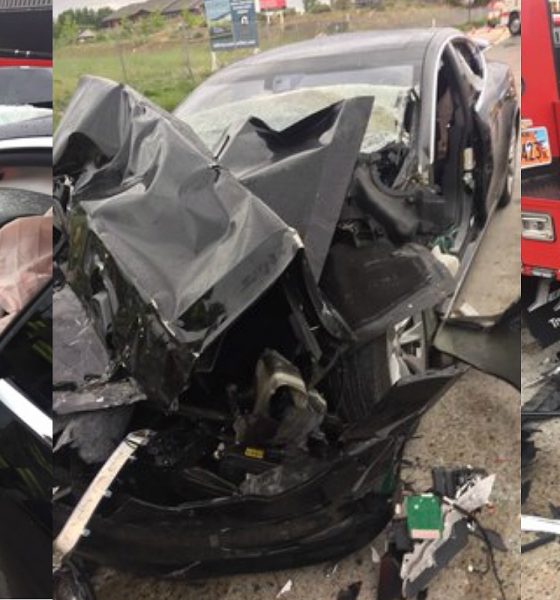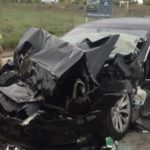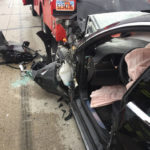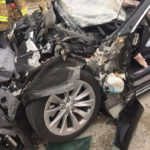

News
Tesla provides details on recent Autopilot crash amid NHTSA investigation
Tesla has released its findings about the recent Model S Autopilot crash in South Jordan, Utah. The accident, which involved a Model S crashing into a parked firetruck at 60 mph last Friday, is currently under investigation by the NHTSA. The driver of the Model S, a 28-year-old Lehi woman who escaped the collision with a broken ankle, later stated that the car had been on Autopilot when the accident happened.
Technicians from the electric car company have issued their findings after retrieving the vehicle’s logs. Here are the conclusions from Tesla’s report.
- The driver engaged Autosteer and Traffic Aware Cruise Control on multiple occasions during this drive cycle. She repeatedly canceled and then re-engaged these features, and regularly adjusted the vehicle’s cruising speed.
- Drivers are repeatedly advised Autopilot features do not make Tesla vehicles “autonomous” and that the driver absolutely must remain vigilant with their eyes on the road, hands on the wheel and they must be prepared to take any and all action necessary to avoid hazards on the road.
- The vehicle registered more than a dozen instances of her hands being off the steering wheel in this drive cycle. On two such occasions, she had her hands off the wheel for more than one minute each time and her hands came back on only after a visual alert was provided. Each time she put her hands back on the wheel, she took them back off the wheel after a few seconds.
- About 1 minute and 22 seconds before the crash, she re-enabled Autosteer and Cruise Control, and then, within two seconds, took her hands off the steering wheel again. She did not touch the steering wheel for the next 80 seconds until the crash happened; this is consistent with her admission that she was looking at her phone at the time.
- The vehicle was traveling at about 60 mph when the crash happened. This is the speed the driver selected.
- The driver manually pressed the vehicle brake pedal fractions of a second prior to the crash.
- Contrary to the proper use of Autopilot, the driver did not pay attention to the road at all times, did not keep her hands on the steering wheel, and she used it on a street with no center median and with stoplight-controlled intersections.
In a statement to the Deseret News, South Jordan Police Sgt. Sam Winkler stated that the driver of the electric car had been looking at her smartphone because she was searching for an alternate route.
“She looked up just as the accident was about to happen,” Winkler said.
Police have issued the Model S driver with a traffic citation due to her “failure to keep a proper lookout.” The citation was issued to the Model S driver this Wednesday.
The NHTSA has opened an investigation on the accident on Wednesday as well. In an emailed statement to CNBC News, the NHTSA noted that it is deploying a special investigation team to gather information about the accident.
“Consistent with NHTSA’s oversight and authority over the safety of all motor vehicles and equipment, the agency has launched its special crash investigations team to gather information on the South Jordan, Utah, crash. NHTSA will take appropriate action based on its review,” the NHTSA wrote.
- The aftermath of the Tesla Model S crash in Utah. [Credit: Good4Utah News]
- The aftermath of the Tesla Model S crash in Utah. [Credit: Good4Utah News]
- The aftermath of the Tesla Model S crash in Utah. [Credit: Good4Utah News]
Tesla CEO Elon Musk has commented on the crash through his personal Twitter account, stating that what’s noteworthy about the accident was that the driver of the vehicle only broke an ankle despite crashing into a firetruck at 60 mph. Musk noted that such accidents at such speeds “usually result in severe injury or death.” In a later tweet, however, Musk stated that Autopilot does need to get better.
It certainly needs to be better & we work to improve it every day, but perfect is enemy of good. A system that, on balance, saves lives & reduces injuries should be released.
— Elon Musk (@elonmusk) May 14, 2018
Tesla’s Autopilot system is a focal point of an ongoing NTSB investigation about a Model X crash near Mountain View, CA. During that incident, the Model X smashed into a bare crash attenuator while traveling at highway speeds, resulting in the tragic loss of its driver. Tesla and the NTSB ultimately parted ways as the investigation proceeded, mainly due to the electric car maker’s release of data pertaining to the crash before the NTSB’s investigation was complete.

News
Tesla starts showing how FSD will change lives in Europe
Local officials tested the system on narrow country roads and were impressed by FSD’s smooth, human-like driving, with some calling the service a game-changer for everyday life in areas that are far from urban centers.

Tesla has launched Europe’s first public shuttle service using Full Self-Driving (Supervised) in the rural Eifelkreis Bitburg-Prüm region of Germany, demonstrating how the technology can restore independence and mobility for people who struggle with limited transport options.
Local officials tested the system on narrow country roads and were impressed by FSD’s smooth, human-like driving, with some calling the service a game-changer for everyday life in areas that are far from urban centers.
Officials see real impact on rural residents
Arzfeld Mayor Johannes Kuhl and District Administrator Andreas Kruppert personally tested the Tesla shuttle service. This allowed them to see just how well FSD navigated winding lanes and rural roads confidently. Kruppert said, “Autonomous driving sounds like science fiction to many, but we simply see here that it works totally well in rural regions too.” Kuhl, for his part, also noted that FSD “feels like a very experienced driver.”
The pilot complements the area’s “Citizen Bus” program, which provides on-demand rides for elderly residents who can no longer drive themselves. Tesla Europe shared a video of a demonstration of the service, highlighting how FSD gives people their freedom back, even in places where public transport is not as prevalent.
What the Ministry for Economic Affairs and Transport says
Rhineland-Palatinate’s Minister Daniela Schmitt supported the project, praising the collaboration that made this “first of its kind in Europe” possible. As per the ministry, the rural rollout for the service shows FSD’s potential beyond major cities, and it delivers tangible benefits like grocery runs, doctor visits, and social connections for isolated residents.
“Reliable and flexible mobility is especially vital in rural areas. With the launch of a shuttle service using self-driving vehicles (FSD supervised) by Tesla in the Eifelkreis Bitburg-Prüm, an innovative pilot project is now getting underway that complements local community bus services. It is the first project of its kind in Europe.
“The result is a real gain for rural mobility: greater accessibility, more flexibility and tangible benefits for everyday life. A strong signal for innovation, cooperation and future-oriented mobility beyond urban centers,” the ministry wrote in a LinkedIn post.
News
Tesla China quietly posts Robotaxi-related job listing
Tesla China is currently seeking a Low Voltage Electrical Engineer to work on circuit board design for the company’s autonomous vehicles.

Tesla has posted a new job listing in Shanghai explicitly tied to its Robotaxi program, fueling speculation that the company is preparing to launch its dedicated autonomous ride-hailing service in China.
As noted in the listing, Tesla China is currently seeking a Low Voltage Electrical Engineer to work on circuit board design for the company’s autonomous vehicles.
Robotaxi-specific role
The listing, which was shared on social media platform X by industry watcher @tslaming, suggested that Tesla China is looking to fill the role urgently. The job listing itself specifically mentions that the person hired for the role will be working on the Low Voltage Hardware team, which would design the circuit boards that would serve as the nervous system of the Robotaxi.
Key tasks for the role, as indicated in the job listing, include collaboration with PCB layout, firmware, mechanical, program management, and validation teams, among other responsibilities. The role is based in Shanghai.
China Robotaxi launch
China represents a massive potential market for robotaxis, with its dense urban centers and supportive policies in select cities. Tesla has limited permission to roll out FSD in the country, though despite this, its vehicles have been hailed as among the best in the market when it comes to autonomous features. So far, at least, it appears that China supports Tesla’s FSD and Robotaxi rollout.
This was hinted at in November, when Tesla brought the Cybercab to the 8th China International Import Expo (CIIE) in Shanghai, marking the first time that the autonomous two-seater was brought to the Asia-Pacific region. The vehicle, despite not having a release date in China, received a significant amount of interest among the event’s attendees.
Elon Musk
Elon Musk and Tesla AI Director share insights after empty driver seat Robotaxi rides
The executives’ unoccupied tests hint at the rapid progress of Tesla’s unsupervised Robotaxi efforts.

Tesla CEO Elon Musk and AI Director Ashok Elluswamy celebrated Christmas Eve by sharing personal experiences with Robotaxi vehicles that had no safety monitor or occupant in the driver’s seat. Musk described the system’s “perfect driving” around Austin, while Elluswamy posted video from the back seat, calling it “an amazing experience.”
The executives’ unoccupied tests hint at the rapid progress of Tesla’s unsupervised Robotaxi efforts.
Elon and Ashok’s firsthand Robotaxi insights
Prior to Musk and the Tesla AI Director’s posts, sightings of unmanned Teslas navigating public roads were widely shared on social media. One such vehicle was spotted in Austin, Texas, which Elon Musk acknowleged by stating that “Testing is underway with no occupants in the car.”
Based on his Christmas Eve post, Musk seemed to have tested an unmanned Tesla himself. “A Tesla with no safety monitor in the car and me sitting in the passenger seat took me all around Austin on Sunday with perfect driving,” Musk wrote in his post.
Elluswamy responded with a 2-minute video showing himself in the rear of an unmanned Tesla. The video featured the vehicle’s empty front seats, as well as its smooth handling through real-world traffic. He captioned his video with the words, “It’s an amazing experience!”
Towards Unsupervised operations
During an xAI Hackathon earlier this month, Elon Musk mentioned that Tesla owed be removing Safety Monitors from its Robotaxis in Austin in just three weeks. “Unsupervised is pretty much solved at this point. So there will be Tesla Robotaxis operating in Austin with no one in them. Not even anyone in the passenger seat in about three weeks,” he said. Musk echoed similar estimates at the 2025 Annual Shareholder Meeting and the Q3 2025 earnings call.
Considering the insights that were posted Musk and Elluswamy, it does appear that Tesla is working hard towards operating its Robotaxis with no safety monitors. This is quite impressive considering that the service was launched just earlier this year.












